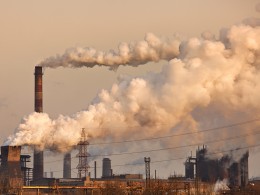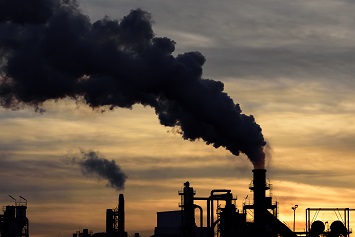There is a strong push at the EPA from the White House, Congress, and from some states to assign more weight to background ozone levels in designating areas in or out of attainment with the National Ambient Air Quality Standards (NAAQS) for ozone. Probably the most controversial type of background ozone is ozone from other countries that drifts into the United States. Some states claim that the majority of monitored ozone in their nonattainment areas originates in Mexico, Canada, and Asia. Others argue that background ozone levels on high ozone days are not much different than they are on days when the ozone NAAQS is being met; in other words, the NAAQS exceedances are being caused by anthropogenic sources in the United States. Disagreements of this type suggest that the study of international transport of ozone or ozone precursors is still in its early stages.
Understanding and accounting for background ozone, particularly as it affects state ability to achieve attainment with the ozone NAAQS, was the topic of discussion at a June 21, 2018, hearing of the House Subcommittee on Environment.
The relationship of background ozone and NAAQS designations has been a hot topic since the EPA revised the primary NAAQS in 2015 by lowering the standard from 75 parts per billion (ppb) to 70 ppb. The revision potentially cast many areas into nonattainment, which local governments view as a significant impediment to new and expanded business. Under the Clean Air Act (CAA), to ensure that air quality will not worsen in a nonattainment area, new businesses and expanded businesses that are major sources of emissions must obtain New Source Review (NSR) permits. These permits compel the facility to obtain permanent air pollution offsets from other sources within their area and also to install current pollution control equipment. As one witness at the hearing noted, rural areas that claim almost all their ozone is from international transport generally do not have many large industrial facilities, which makes it exceedingly difficult to obtain offsets. The consequence can be no new development, which hurts the local economy and employment. This penalty is patently unfair, noted Rep. Lamar Smith (R-TX) at the hearing.
“In some areas of the country, even background ozone levels exceed 70 parts per billion,” said Smith. “In these areas, no matter how much a state controls its own emissions it will never be able to comply with the 2015 NAAQS level. We cannot beat mother nature and we cannot force other countries to stop their emissions. Geographic areas should not be held accountable for emissions they can’t control.”
Various Sources
Background ozone, which is also defined as ozone that cannot be reasonably controlled, can have several origins, including exceptional events such as forest fires. States that wish to claim that short-term exceedances of the ozone NAAQS were caused by exceptional events must provide the EPA with a substantial amount of scientific data (e.g., monitoring and modeling information that compares conditions during the exceptional event and normal periods, as well as wind conditions and distance between the exceptional event and the monitors) to demonstrate that there was a clear causal relationship between a specific event and a monitored exceedance or violation.
Other types of background ozone can originate from soil and lightning and hydrocarbon emissions from vegetation. But ozone in the United States that originates mainly from Mexico and Asia appears to be the major culprit in arguments made by states that will have difficulty meeting the 2015 ozone NAAQS. For example, according to some states in the Southwest, ozone arriving from other nations accounts for a significant amount of ozone measured in their nonattainment areas.
Conditions in the Southwest
At the House hearing, Diane D. Rath, executive director of the Alamo Area Council of Governments, testified on the impact of international ozone on the San Antonio-New Braunfels Metropolitan Statistical Area (MSA).
“It is estimated that areas within Texas (including the San Antonio-New Braunfels MSA contribute up to 36.6 percent of San Antonio’s ozone,” said Rath. “Areas outside Texas but within the modeling domain (including southern Canada, northern Mexico, the northwest Caribbean, and adjacent offshore areas) contribute 25 percent to San Antonio’s ozone.”
The situation may be even worse in Arizona, according to Timothy Franquist, air quality director at the Arizona Department of Environmental Quality.
“The most recent U.S. EPA model indicates that over 83 percent of ozone in Southern Arizona is attributed to international sources,” said Franquist. “Arizona is not only impacted by Mexican emissions, 65 percent of the increase in ozone in the Southwest is attributed to international transport from Asia, according to a surface ozone study conducted by a team of researchers from NOAA [National Oceanic and Atmospheric Administration], Princeton University, Columbia University, and the U.S. EPA. The surface ozone study further indicates that during summertime in the Western U.S., ‘increasing Asian emissions approximately offset the benefits of U.S. emissions reductions.’”

CAA Sections 179(B) and 182(h)
The CAA provides two tools to assist states with areas in NAAQS nonattainment because of international pollution.
Under CAA Section 179(B), the EPA must approve a state implementation plan (SIP) to achieve an NAAQS if the “submitting state establishes to the satisfaction of the Administrator that the implementation plan of such state would be adequate to attain and maintain the relevant national ambient air quality standards by the attainment date specified under the applicable provision of this chapter, or in a regulation promulgated under such provision, but for emissions emanating from outside of the United States.” (emphasis added)
When applicable, this CAA provision relieves states from imposing control measures on emissions sources in the state’s jurisdiction beyond those necessary to address reasonably controllable emissions from within the United States.
But, as pointed out by Arizona’s Franquist in discussing the ozone NAAQS challenge in Yuma—a new ozone nonattainment area proposed by the U.S. EPA as of April 2018—a state can submit an international transport demonstration only after 3 years of the area not meeting the standard.
“Yuma will remain in perpetual nonattainment until international emissions decrease to the extent that Yuma attains the ozone standard,” said Franquist. “The international transport demonstration does nothing to better protect Yuma residents from the health impacts of international pollution or lessen the burden on their local economy.”
Also, CAA Section 182(h) allows the EPA to determine that a designated nonattainment area can be treated as a rural transport area if the area does not contain emissions sources that make significant contribution to the monitored ozone concentration in the area or other areas; and the area does not include and is not adjacent to an MSA. A rural transport area in nonattainment is given a marginal designation. This is the least stringent classification for a nonattainment area and doesn’t require the state to submit a SIP.
In May 2018, Jeff Flake and John McCain, Arizona’s two Republican senators, introduced their Air Designation Actions in Areas of Pollutant Transport Act (S. 2825). The bill would amend the CAA to provide more relief to areas afflicted by international pollution transport. One proposed revision would extend the availability of a rural transport designations to nonattainment areas that include or are adjacent to an MSA. Another provision would provide states with assurances of timely approvals or disapprovals of state submittals seeking regulatory relief for nonattainment areas impacted by international transport or that qualify as a rural transport area.

President’s Memo
The White House has also entered the discussion on international pollution. In an April 2018 memo, President Donald Trump directed the EPA to take specific actions to ensure efficient and cost-effective implementation of the NAAQS program. As with S. 2825, the memo instructed the EPA to “endeavor” to take final action within 120 days of a complete submission of a state demonstration or petition relating to international emissions.
In addition, the memo stated that the EPA must continue to take into consideration a state’s ability to meet and attain NAAQS that may be affected by international transport of criteria pollutants. With regard to all demonstrations or petitions submitted pursuant to Section 179B of the CAA, the EPA was directed to seek to ensure that it does not limit its consideration of demonstrations or petitions to those submitted by states located on the borders of the United States and Mexico or Canada but, rather, to consider Section 179B demonstrations or petitions submitted by any state. Additionally, with respect to Section 179B demonstrations or petitions, the EPA may not limit its consideration to emissions emanating from Mexico or Canada but, rather, must consider, where appropriate, emissions that may emanate from any location outside the United States, including emissions from Asia.
Evolving Science
At the hearing, Gregory Stella, an air quality scientist, noted that much of the science of determining ozone contributions from international sources was focused on eliminating uncertainties.
“Because amounts of ozone measured at ambient air quality monitors cannot be separated into background or anthropogenic origin, this amount needs to be determined using photochemical modeling and source apportionment tools,” said Stella. “We know that many sources of background ozone are global in origin, and the fact that ozone is not emitted directly, rather, it is formed by reaction of hydrocarbon and nitrogen species in the presence of sunlight complicates the linkage of particular emissions to downwind ozone concentrations.”
Even with these uncertainties, Stella said scientists have found that background ozone can range from 10 percent of the modeled contribution to close to 90 percent on any single modeled day.
“Over an entire year, this can average to greater than 50 ppb of total modeled ozone depending on location; with higher background contribution seen in the western, high elevation monitor locations,” Stella said. “This is a large fraction of the current 70 ppb ozone standard and can make it very difficult, if not impossible, for many regions of the country to attain the NAAQS. As much as 85 percent of modeled ozone in the western Rockies region comes from categories other than U.S. anthropogenic sources with a minimum of no less than 18 percent contribution across the rest of the country.”
But Stella warned that international emissions—and, hence, their impact on ozone concentrations in the United States—are subject to change.
“Global emissions are not constant and therefore background contributions also vary from year to year,” said Stella. “Understanding these changes to adequately include and project future years’ background concentrations is extremely important if we are to define effective national, regional, or local control programs.
“In summary, it is absolutely clear that there is an ever increasing impact of uncontrollable emission sources on the ability of our states to achieve attainment with the current air quality standards. While much work has occurred related to the understanding of background ozone and international transport’s contribution to locally observed air quality concentrations, we still have a long way to go in understanding the contribution of these sources and improving the models and methods used to quantify and qualify their use in a regulatory framework.”

